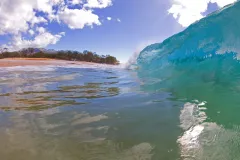Shooting the Waves: Tips from a Surf Photographer

A great surf photograph appears loose and improvised, like the waves and surfers it depicts. The reality is less spontaneous. The photos that you see in surf magazines rarely happen by accident, and could never be captured without preparation and planning that can start months before—all to capture a moment that lasts a fraction of a second.

Hauling your bulky camera and housing through the surf is rarely easy, and staying in shape to withstand wave power takes ongoing work. To train, I swim in the ocean and in pools. I practice holding my breath. I spend time treading water. I kick hundreds and hundreds of yards with fins every workout session. Being in shape not only makes the work easier, but also may be your key to survival when shooting in bigger waves.

A surf photographer has a second body to look after: the camera body. Underwater camera housings can be finicky, and require regular care and maintenance. An incoming wave flooding a housing and killing a camera is a matter of “when”, not “if,” for surf photographers; the more time you spend in the water, the more likely it becomes that you will ruin a camera. Lubrication, care and cleaning of the housing are a regular ritual to delay the inevitable and protect your equipment.

One of the most important factors in surf photography is out of our control: weather. Knowing what surf breaks will have the best waves is crucial to putting yourself in the right place at the right time—and you get that knowledge from experience. The best swells come from storms hundreds if not thousands of miles away; a single storm can create good waves in some surf spots but poor ones in others. Tides affect the way waves break, so knowing tide times and how the tide impacts the break you want to shoot is part of the equation. You have to consider sunlight too. Generally, clear, sunny days will give you the best photos, and for individual shots sunshine determines whether your images will be front-lit or backlit. Waiting a few hours can mean dramatically different shooting and water conditions.

The last detail is the surfers themselves. Working the phone in advance of the swell is sometimes crucial to getting good photos because it helps to have subjects to shoot. Some breaks will attract talented surfers, but you may need to round up a few willing surfers to join you at your chosen break ahead of time. Having willing subjects at the right place at the right time can make the shooting much more successful.
- Chris Stankis, Photographer
These photo submissions were on display at the Smithsonian National Museum of Natural History alongside those taken by photojournalist Brian Skerry in the exhibit Portraits of Planet Ocean. The exhibit is now closed.

